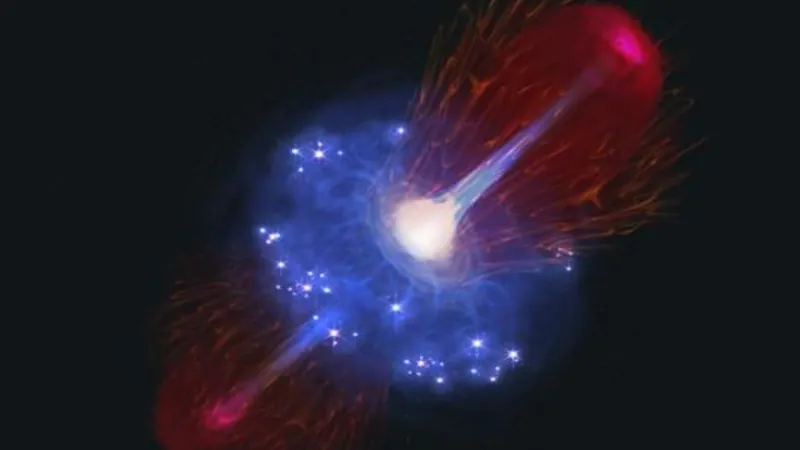
James Webb Space Telescope Reveals Dormant Supermassive Black Hole: A Chilling Encounter with an Ancient Monster!
2024-12-18
Author: Chun
Introduction
In a discovery that has astronomers buzzing with excitement, the James Webb Space Telescope (JWST) has uncovered a colossal black hole in a state of dormancy, resting peacefully after a bout of rapid cosmic consumption. This fantastic find provides insight into the enigmatic nature of supermassive black holes in the early universe, a subject that has long puzzled scientists.
The Discovery
This dormant supermassive black hole, located a staggering 800 million years after the Big Bang, is a true giant in the cosmos, boasting a mass approximately 400 million times that of our sun. This remarkable size makes it the most massive black hole observed by JWST from that early period of the universe, according to research published in the prestigious journal Nature.
Intriguing Size and Feeding Dynamics
What makes this black hole particularly intriguing is its size relative to its host galaxy. Typically, supermassive black holes contain about 0.1% of their galaxy’s mass; however, this one makes up an astonishing 40% of its galaxy's total mass. Despite its apparent brawn, the black hole is only slowly feeding on gas, consuming at a mere one-hundredth of its maximum accretion potential. This newfound revelation raises questions about how such particularly sizable black holes could form and exist in such a short period post-Big Bang.
Detection of the Dormant Giant
Under normal circumstances, black holes are cloaked by 'event horizons,' trapping light and making them invisible unless they are actively feeding on surrounding matter—resulting in a glowing accretion disk. Yet, due to its immense gravitational influence, this dormant giant was detected even without aggressive feeding behaviors. Team leader Ignas Juodžebalis from Cambridge’s Kavli Institute for Cosmology remarked, "Even though this black hole is dormant, its enormous size made it possible for us to detect. Its dormant state allowed us to learn about the mass of the host galaxy as well. The early universe managed to produce some absolute monsters, even in relatively tiny galaxies."
Groundbreaking Implications
The finding is groundbreaking as it complicates current theories about black hole evolution. While it’s established that supermassive black holes grow through cosmic mergers and the steady consumption of gas, spotting one at such an early stage is a significant puzzle. The JWST began observations in 2022, and astronomers are increasingly uncovering more of these formidable titans lurking in the universe's infancy—some dating back just 600 million years after the Big Bang.
Speculations on Growth and Dormancy
Researchers further speculate that these supermassive black holes might not only grow quickly through sporadic feeding frenzies, termed 'super-Eddington accretion,' but may also experience long periods of dormancy. According to Kavli researcher Roberto Maiolino, early black holes might “be born big” or undergo intense phases of hyperactivity separated by lengthy naps that last 10 to 20 times longer than their active periods.
Current Simulations and Theories
Current simulations indicate that early black holes may push the limits of how much material they can consume in short bursts, thereby exceeding the 'Eddington limit'—the point where radiation pressure from their feeding activities can diminish or halt further gas intake. This newfound understanding could explain why such immense black holes can form so swiftly after the birth of the universe.
Looking Ahead
This discovery may just be the beginning, as the research team believes many more dormant black holes are hidden in the universe’s depths, waiting to be found. "It’s likely that the vast majority of black holes out there are in this dormant state. I’m excited to think that there are so many more we could find," concluded Maiolino.
Conclusion
As we delve deeper into the cosmos with cutting-edge technology like the JWST, our understanding of these ancient, sleeping giants may just reshape our perception of the universe and its eerie, extravagant origins. Who knows what other cosmic secrets lie in the shadows, waiting to be revealed? Stay tuned!




 Brasil (PT)
Brasil (PT)
 Canada (EN)
Canada (EN)
 Chile (ES)
Chile (ES)
 España (ES)
España (ES)
 France (FR)
France (FR)
 Hong Kong (EN)
Hong Kong (EN)
 Italia (IT)
Italia (IT)
 日本 (JA)
日本 (JA)
 Magyarország (HU)
Magyarország (HU)
 Norge (NO)
Norge (NO)
 Polska (PL)
Polska (PL)
 Schweiz (DE)
Schweiz (DE)
 Singapore (EN)
Singapore (EN)
 Sverige (SV)
Sverige (SV)
 Suomi (FI)
Suomi (FI)
 Türkiye (TR)
Türkiye (TR)